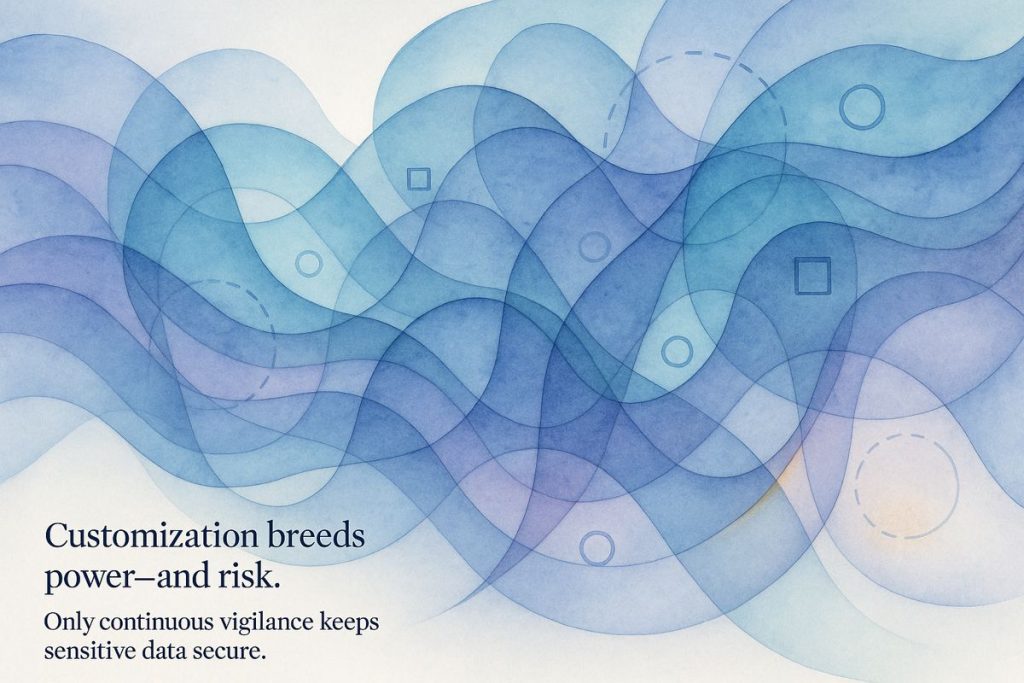Salesforce security in the pharmaceutical world is like walking a tightrope—companies want the freedom to customize, but every change risks exposing sensitive data. Too many custom features, sloppy permissions, and sneaky unsanctioned tools can turn the system into a messy and dangerous place. Automated tools like Project Guard act like digital watchdogs, catching mistakes and guarding against leaks before they become disasters. With strict rules and ever-changing regulations, pharma companies must stay alert, using smart tools to protect their secrets and patients at all times.
What are the main Salesforce security challenges in the pharmaceutical industry?
Salesforce security in pharma faces challenges like excessive customization, misconfigured permissions, shadow IT, and evolving regulatory requirements. Automated tools like Project Guard help detect and remediate risks by monitoring configurations, enforcing compliance frameworks, and providing real-time alerts, ensuring sensitive data and intellectual property remain protected.
The Delicate Art of Customization
Let’s begin with a confession: The first time I saw a pharma client’s Salesforce org—twenty-three custom objects, a spaghetti bowl of Apex triggers, and enough integrations to make a grown admin weep—I felt equal parts awe and dread. The platform’s vaunted adaptability is both its superpower and Achilles’ heel, especially when you’re wrangling intellectual property or patient data under the watchful gaze of HIPAA or GDPR.
Salesforce is, of course, the ultimate chameleon, morphing to fit clinical trial workflows, R&D pipelines, and commercial operations alike. Pfizer, for instance, leverages Salesforce for everything from adverse event tracking to global sales orchestration. But what happens when every department wants its own bespoke process? Things get hairy—fast.
I once watched a permissions matrix evolve from a tidy 12 rows to a palimpsest of 87, with color-coded cells bleeding into each other like watercolors in the rain. (The scent of burnt coffee and panic—unforgettable.) That’s when I had to stop and ask myself: Did I just enable innovation, or did I open Pandora’s box?
Where Security Starts to Fray
Here’s the catch. Every new custom field or integration is a thread in a web—sometimes a trap, sometimes a safety net. As Pablo Gonzalez at AutoRABIT recently pointed out, customization done in haste, or without clear oversight, leaves behind a legacy of risk. The shared responsibility model only complicates things: Salesforce secures the infrastructure, but you, dear reader, are responsible for the fortress walls around your data. (And if you think Salesforce’s out-of-the-box tools suffice—think again.)
Misconfigured role hierarchies become landmines. Ever heard of “permission creep”? It’s the phenomenon where users quietly acquire more access than they need, often through a well-intentioned admin’s click. Suddenly, your clinical trial assistant can view product launch plans—oops. I once saw an org where a lone developer, through a quirk of inherited permissions, could delete patient data. The horror.
Then there’s shadow IT, lurking like a mischievous poltergeist. Integrations or automations spun up without IT’s blessing—because “it’s just a quick fix”—become invisible vulnerabilities. Try tracing that during a GDPR audit. Ugh.
Project Guard and the Automated Sentry
The Rise of Hypergranular Defenses
So, what’s the antidote to this swirling chaos? Enter the hyperspectral realm of automated security monitoring. AutoRABIT’s Project Guard, as highlighted in recent industry chatter, is the latest in a new breed of tools—think of them as the canaries in your digital coal mine, constantly sniffing out misconfigurations and compliance breaches.
Project Guard doesn’t just flag issues after the fact. It provides real-time alerts when, say, two “toxic” permissions combine to give a user carte blanche over sensitive tables. Suddenly, your org isn’t a house of cards—it’s a fortress with laser tripwires.
One day, I watched as Guard highlighted a seemingly innocuous change: a new API integration with a partner lab. The alert made us dig deeper, revealing that the partner’s access level was, in fact, dangerously broad. Bam! Crisis averted, and my skepticism softened—just a tad.
Translating Security for Mere Mortals
Here’s what makes Project Guard and similar platforms (like Salesforce Shield, but with more bite) stand out: they don’t just spit out thousand-line logs. They translate technical arcana into actionable steps, even for those of us who don’t dream in SOQL. Non-technical stakeholders—think compliance officers or C-level execs—finally get visibility into their Salesforce risk surface. No more hand-waving or “trust me, it’s fine.”
You can import compliance frameworks (ISO 27001, PCI-DSS, FDA 21 CFR Part 11) as baselines and enforce them at scale. Audit trails become a living document, not a dusty afterthought. And when the next regulatory update hits—brace yourself, it’s only a matter of time—the system morphs in tandem, not weeks behind.
Embracing DevSecOps
In pharma, DevSecOps isn’t just a buzzword—it’s a survival tactic. By integrating automated security checks into every code push and process tweak, teams can catch vulnerabilities before they reach production. No more “move fast and break things”—at least not without a safety net.
I recall an early-morning code review where AutoRABIT flagged a misconfigured sharing rule minutes before a sprint deployment. Relief washed over me. (Honestly, I’d rather find a moth in my tea than a data leak in production.)
Staying Ahead in the Regulatory Rat Race
Why Security Is Existential—Not Optional
Make no mistake: For pharma and life sciences, the cost of a Salesforce breach goes far beyond a slap on the wrist. We’re talking multi-million dollar fines, shredded reputations, and, in some cases, patient harm. Roche and Novartis have both faced close calls—though details are often buried under NDA and legalese.
Regulatory frameworks are relentless, mutating like a particularly persistent virus. If you’re not continuously monitoring and adapting, you’re already behind. The emotional toll? Somewhere between anxiety and outright dread, if I’m honest.
Best Practices to Remember (and Sometimes Forget)
First, continuous security posture management—never treat compliance as a checklist. Use automated tools that scan, alert, and even remediate with a single click. Second, principle of least privilege—audit those permissions like your career depends on it. (It might.) Third, **never trust shadow
